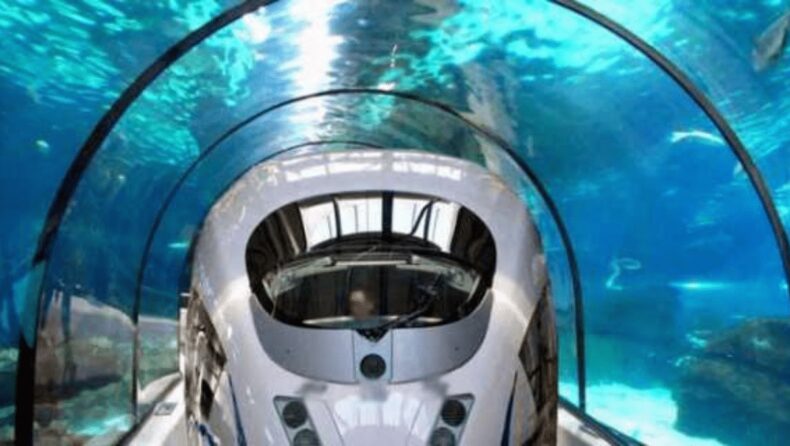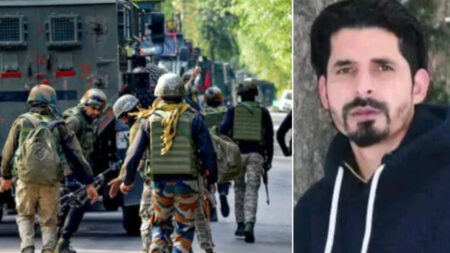NHSRCL (National High-Speed Rail Corporation Limited) invited bids for the construction of a 21 km long tunnel for the Mumbai-Ahmedabad High-Speed Rail Corridor in Maharashtra State.
In a 21 km long tunnel, seven kilometres long will be an underwater sea tunnel at Thane Creek, an intertidal zone (on the shore, between high tide and low tide, where sea and land meet).
The tunnel is between the Bandra-Kurla Complex underground station and Shilphata in the Thane district of Maharashtra.
This is India’s first seven-kilometre-long underwater sea tunnel for Mumbai -Ahmedabad High-Speed Rail Corridor (MAHSRC).
The underwater tunnel has twin tracks
The seven-kilometre underwater tunnel is going to be a single tube that accommodates twin tracks for both up and down tracks.

In general, a diameter of five to six-meter cutter head is used for Mass Rapid Transit System Metro System, but for the bullet train underwater sea tunnel, a Tunnel Boring Machine (TBM) with a diameter of 13.1-meter cutter head going to be used.
In a 21km long tunnel, about 16 km of the tunnel is completed using three TBM and the rest of five kilometres will be completed by using the New Austrian Tunnelling Method.
The tunnel going to be about 25 to 65 meters deep from ground level and the deepest construction point is 114 metres below Parsik hill near Shilphata, Thane district of Maharashtra.
Maharashtra government nod to allot forest land
Recently state government has permitted to allot forest land for the project by signing a shareholder agreement with NHSRCL.
Even the Union Ministry of Environment, Forests and Climate Change gave final approval for the diversion of forest land.
Chief Minister Eknath Shinde directed authorities to complete all land acquisitions for the bullet train project by September 30.

After the Maharashtra government clears all land acquisition issues in the state will boost the bullet train project ahead of assembly elections scheduled in Gujarat later this year.
The Bullet train project between Mumbai and Ahmedabad is a pet project of Prime Minister Narendra Modi and is now gaining momentum with land clearances from the Maharashtra government.
The National High-Speed Rail Corporation Limited (NHSRCL), the body that is undertaking the construction has a special purpose vehicle comprising 50 per cent stake of the central government and 25 per cent each stake of both state governments of Maharashtra and Gujarat.
BKC underground station
The Maharashtra government has directed Mumbai Metropolitan Development Authority to make land available for the project.
After such announcements from the state government, NHSRCL will call for tenders for Bandra Kurla Complex (BKC) station construction on October 20. BKC station is the only underground station in the entire corridor
The simulators used for training purposes of the MAHSR train drivers and staff, which will be responsible to operate high-speed trains, are going to be set up in Vadodara in Gujarat.

In two types of simulators, the primary type will be for training the crew that will be onboard the high-speed train while in the secondary one, driver cabins are provided to accommodate 10 trainee pilots to have a first-hand experience of operating bullet trains.
In Maharashtra, the NHSRCL has acquired 72 per cent of the land required for the project, but only 39 per cent is their physical position.
Bullet train trails from 2026
The first bullet train trails will be between Surat and Bilimora route which is a 50 km distance in 2026 and regular operations will commence from 2027.
Surat station is the first bullet train station and will be inaugurated by September 2024.

Soon four out of 12 stations i.e. Vapi, Silimora, Surat and Bharuch stations are going to be inaugurated by December 2024.
The maintenance and supply of updated technology for the bullet train project provided by Japan. The technology utilised in the bullet train is the E5 Shinkansen and an upgraded version of the technology will be provided in the future that suits India’s weather conditions and pollution.
The technology is predicated on a crash avoidance system that also includes state of an art signalling system. The design of the coach makes an accident-free train.
The bullet train coaches will be anti-seismic in nature. Few train coaches will ship to India for assembling, says NHSRCL official.
Bullet train project details
The total length of the route is 508.17 km and the bullet train makes it possible to travel between Mumbai and Ahmedabad within three hours at the maximum operating speed of the bullet train is 320 kmph.
The project is estimated at Rs 1.1 lakh crore and is being built with financing from the Japan International Cooperation Agency (JICA).
Mumbai Ahmedabad High-Speed Rail Corridor (MAHSRC) will have 12 stations, eight in Gujarat and four in Maharashtra.
Eight stations in Gujarat state are Vapi, Bilimora, Surat, Bharuch, Vadodara, Anand, Ahmedabad and Sabarmati. While in Maharashtra state, four stations are Mumbai (BKC), Thane, Virar and Boisar.
NHSRCL acquired 97.47 per cent of land
So far, the NHSRCL has acquired 97.47 per cent of the land required for the bullet train project. A total of 98.7 % and 100 % of the land was acquired in Gujarat and Dadra and Nagar Haveli respectively, and in Maharashtra, 94.37 per cent of the required land has been secured. In general, the NHSRCL requires 433.82 hectares in Maharashtra for the project.
Nearly 96 per cent of land has been taken possession in Thane, Palghar, and Mumbai for the project.
In the Thane district, 348 acres of land are required and the state government has acquired 333 acres and executing agency has taken 260 acres.
In Palaghar, out of 712 acres, 675 acres had been acquired by the state government and NHSRCL had possession of 506 acres. In Mumbai, out of the 11.9 acres required, 2.4 acres were handed over to NHSRCL.
A total of 1,070 acres of land is required, of which only 1,015 acres have been acquired for the project in Maharashtra State. Approximately 71 per cent of the acquired land has been handed over to the project executing agency.













